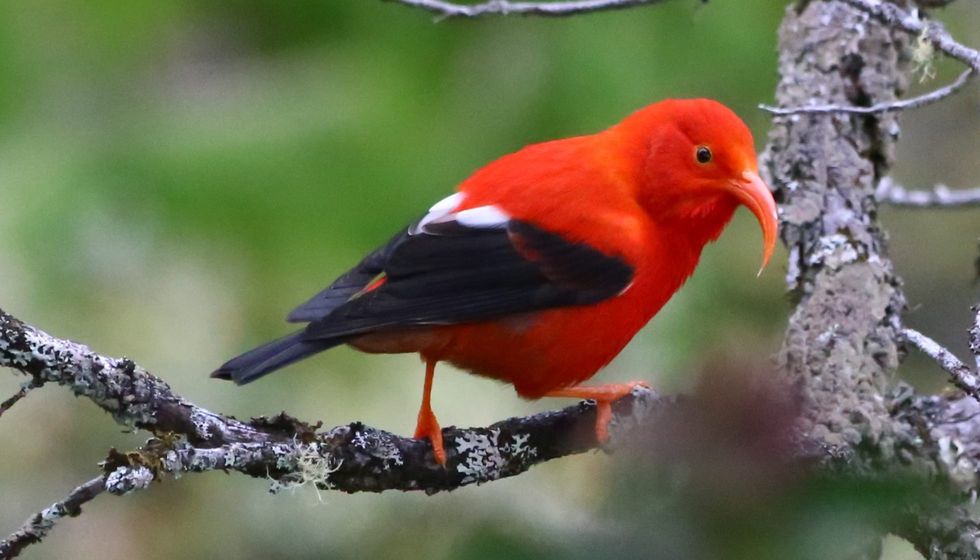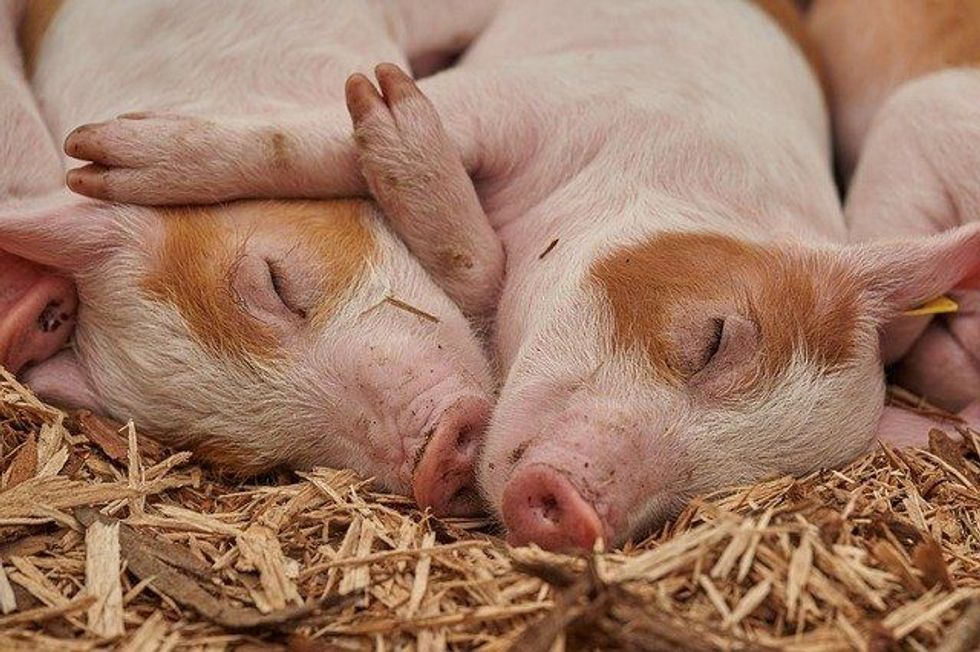The island of Maui in Hawaii was home to one of the cutest passerine species, the po’ouli. This bird was the sole member of the Melamprosops genus.
It is fondly referred to as the black-faced honeycreeper due to the presence of a black mask on its face. The home range of this bird was said to stretch across the southwestern slope of Haleakalā, breeding and nesting in the ‘ōhi‘a lehua forest.
It was in 1973 when the discovery of this bird was made. By then, the numbers of these birds were already declining and immediate measures were taken to protect the po'ouli. Unfortunately, this bird continued to be an endangered specimen, with the last captured bird being a male. Unfortunately, this honeycreeper is Extinct today.
For more relatable content, check out these Hawaiian crow facts and Hawaiian hawk facts for kids.
Po'ouli Interesting Facts
What type of animal is a po'ouli?
The Hawaiian honeycreeper po'ouli is a type of passerine.
What class of animal does a po'ouli belong to?
This Hawaiian specimen belongs to the class Aves.
How many po'oulis are there in the world?
Unfortunately, the po'ouli (Melamprosops phaeosoma) is Extinct today. The last known numbers of this species were only three individuals back in 2003.
Where does a po'ouli live?
The black-faced honeycreeper was entirely endemic to the beautiful island of Maui in the state of Hawaii.
What is a po'ouli's habitat?
Hawaii’s po’ouli bird was said to inhabit the wetter, easternmost parts of the island of Maui. However, as per the fossil records, it is said that this bird lived on the dryer parts of Maui, surviving at altitudes of 902-4429 ft (275-1350 m).
Who do po'oulis live with?
These birds preferred living alone.
How long does a po'ouli live?
We are not aware of the lifespan of this breed of bird.
How do they reproduce?
Unfortunately, we do not have the information about the reproduction behavior of this species. All that is known is that this bird built its nest using small twigs, sticks, and branches.
These birds nested in the beautiful native forests of ‘ōhi‘a lehua (Metrosideros polymorpha). The nests were placed in the tree branches. The only records of their nests reported observed nests between the months of April to June and had only one or two little chicks.
What is their conservation status?
Unfortunately, the IUCN has listed this species as Extinct.
Po'ouli Fun Facts
What do po'oulis look like?
The po'ouli was a small, stocky bird. It had brown tinted feathers above, and was gray-white hued below. You could notice a black mask on its head, extending behind its eyes. In the Hawaiian language, 'po’ouli' translates to ‘black head’ or ‘black face’. This gives the bird its alternate name, the black-faced honeycreeper.
Adult birds of this species were silver-gray above the black mask which slowly transitioned into brown at the crown region, leaving behind a pale patch at the throat. The belly had a soft cream color. These birds had long brown legs and short black bills.
Juvenile birds of this species were very similar to the adults. However, they had buffier bodies with a comparatively smaller black bask. They lacked the gray color above.
How cute are they?
Po'oulis were absolutely adorable.
How do they communicate?
Po'oulis were said to make repetitive 'chik-chik' or 'tweet-tweet' sounds to communicate with other birds of its species. However, these calls were rarely heard.
How big is a po'ouli?
This little Hawaiian forest bird measured a total of 5.5 in (14 cm) in length. This dweller of the Haleakala slopes was twice the size of the rufous hummingbird.
How fast can a po'ouli move?
Unfortunately, there is no data on the speed of this bird which was native to Maui, Hawaii.
How much does a po'ouli weigh?
Records say that the Hawaiian honeycreeper bird weighed less than 1 oz (28.35 g).
What are the male and female names of the species?
There are no specific names for the male and female birds of this species.
What would you call a baby po'ouli?
A baby po'ouli has no specific name. Similar to other birds, a baby bird is normally known as a chick.
What do they eat?
The diet of these birds of the Melamprosops genus consisted mainly of spiders, snails, and insects. Some reports claim that this bird also fed on fruits.
The po’ouli mainly fed on insects, as the hunt for snails required more effort and time. However, there have been times when this Hawaiian species foraged through lichens, bark, and moss and ripped them apart to satisfy their craving for native tree snails.
Are they dangerous?
No, the black-faced honeycreeper was not dangerous at all.
Would they make a good pet?
We do love the idea of having these birds as pets, however they are an Extinct species.
Did you know...
Tissue samples were collected from the last male bird in hopes of cloning in the future.
It has been said that when this species was first discovered in 1973, the population was already very small by then, having an estimate of only 100-200 po’oulis around that time. About 76 po'oulis were present per 0.4 sq mi (1 sq km).
This small population saw a drastic decline in 1981 when only 15 individuals were detected per 0.4 sq mi (1 sq km).
By the next four years, in 1985, only eight birds of this species were present 0.4 sq mi (1 sq km). Thus, within almost a decade, the population had a sharp decline of 90 percent.
When was the po'ouli discovered?
It was back in 1973 when the birds of the then endangered species were discovered. The discovery was made by the students of the University of Hawaii. They found this bird along the north-eastern slopes of the East Maui Volcano, also called the Haleakalā, situated on the island of Maui.
This bird was discovered at an altitude of 6500 ft (1980 m) above sea level, during the Hana Rainforest Project. This bird became the first Hawaiian honeycreeper species to be discovered since the year 1923.
Why did the po'ouli become extinct?
It is really unfortunate to know that today we see the po'ouli Extinct. There were many measures taken to save this bird, which unfortunately did not work out.
One possible reason for extinction could be the arrival of mosquito-borne malaria in birds which spread across this US state. This caused the population of po’oulis dwelling at low elevations to face huge losses. This also led to the po’ouli population moving to the mountain rainforests to avoid the disease.
In the '80s, the po’ouli completely disappeared from the easternmost areas of its range. They were then only found towards the western branch of Maui’s Hanawi Stream.
Realizing the sharp decline in the population of these birds along with other endangered flora and fauna, from its home range, immediate measures were taken. A 14.8 sq mi (38 sq km) piece of land was set aside and the Hanawi Natural Area Reserve was established by the State of Hawaii.
Several protected areas were connected together to make a large area for the protection of this endangered species.
Several groups joined together in this protection effort, namely the Hawaiian government, the National Park Service, Maui County, and The Nature Conservancy. Multiple private companies and organizations also became a part of this group.
Initial activities included fencing off the land. By June 1996, the task of clearing out pigs from these closed areas began.
By the end of four years, about 202 pigs were moved out of this area and completely vacated from the po’ouli area. As the removal of pigs from other pens took place, populations of other native species such as the ʻākohekohe and the Maui parrotbill seemed to rise much faster than expected.
The po’ouli pen was still infested with goats, cats, and rats which were slowly being cleared.
Unfortunately, by 1997, only three po’ouli birds were found to be existing. These three birds had their home ranges located within the beautiful Hanawi Natural Area Reserve as well as the adjacent Haleakala National Park.
In 2002, one of the surviving three, a female, was captured and transferred to the home range of a male po’ouli, with the hope of getting them to breed. However, the female did not stay long and returned back to her territory about 1.5 mi (2.4 km) away the following day.
In 2004, a 10 day expedition was set out, with the aim to capture the three remaining specimens and bring them safely back to a bird conservation center on Maui island. This was set with the hopes of them producing offspring but getting little hope.
In September 2004, one remaining po’ouli was introduced to the Maui Bird Conservation Center. The intention was to make the bird breed in captivity. Unfortunately, a mate could not be found for the bird before it died in November.
The sex of the remaining two birds was not identified. Extensive surveys were carried out to locate these birds.
At that time, the species was declared as Critically Endangered by both IUCN and BirdLife International. However, sometime later, further surveys were carried out which confirmed the extinction of this species.
The population decline of this species was attributed to multiple reasons, such as habitat destruction, mosquito-borne avian diseases, the decline in the availability of native tree snails, and even predation by cats, rats, pigs, and mongooses.
Finally, in 2019, the IUCN declared this endangered species as Extinc’.
Here at Kidadl, we have carefully created lots of interesting family-friendly animal facts for everyone to discover! Learn more about some other birds from our house finch facts and scissor-tailed flycatcher facts pages.
You can even occupy yourself at home by coloring in one of our free printable po'ouli coloring pages.









